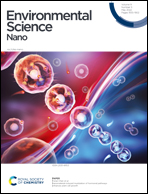Detecting residual chemical disinfectant using an atomic Co–Nx–C anchored neuronal-like carbon catalyst modified amperometric sensor†
Abstract
Hydrogen peroxide (H2O2) solution and its aerosols are common disinfectants, especially for urgent reuse of personal protective equipment during the COVID-19 pandemic. Highly sensitive and selective evaluation of the H2O2 concentration is key to customizing the sufficient disinfection process and avoiding disinfection overuse. Amperometric electrochemical detection is an effective means but poses challenges originated from the precarious state of H2O2. Here, an atomic Co–Nx–C site anchored neuronal-like carbon modified amperometric sensor (denoted as the CoSA-N/C@rGO sensor) is designed, which exhibits a broad detection range (from 250 nM to 50 mM), superior sensitivity (743.3 μA mM−1 cm−2, the best among carbon-based amperometric sensors), strong selectivity (no response to interferents), powerful reliability (only 2.86% decay for one week) and fast response (just 5 s) for residual H2O2 detection. We validated the accuracy and practicability of the CoSA-N/C@rGO sensor in the actual H2O2 disinfection process of personal protective equipment. Further characterization verifies that the electrocatalytic activity and selective reduction of H2O2 is determined by the atomically dispersed Co–Nx–C sites and the high oxygen content of CoSA-N/C@rGO, where the response time and reliability of H2O2 detection is determined by the neuronal-like structure with high nitrogen content. Our findings pave the way for developing a sensor with superior sensitivity, selectivity and stability, rendering promising applications such as medical care and environmental treatment.



 Please wait while we load your content...
Please wait while we load your content...